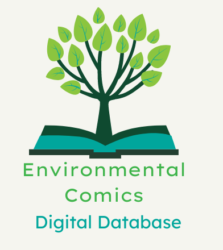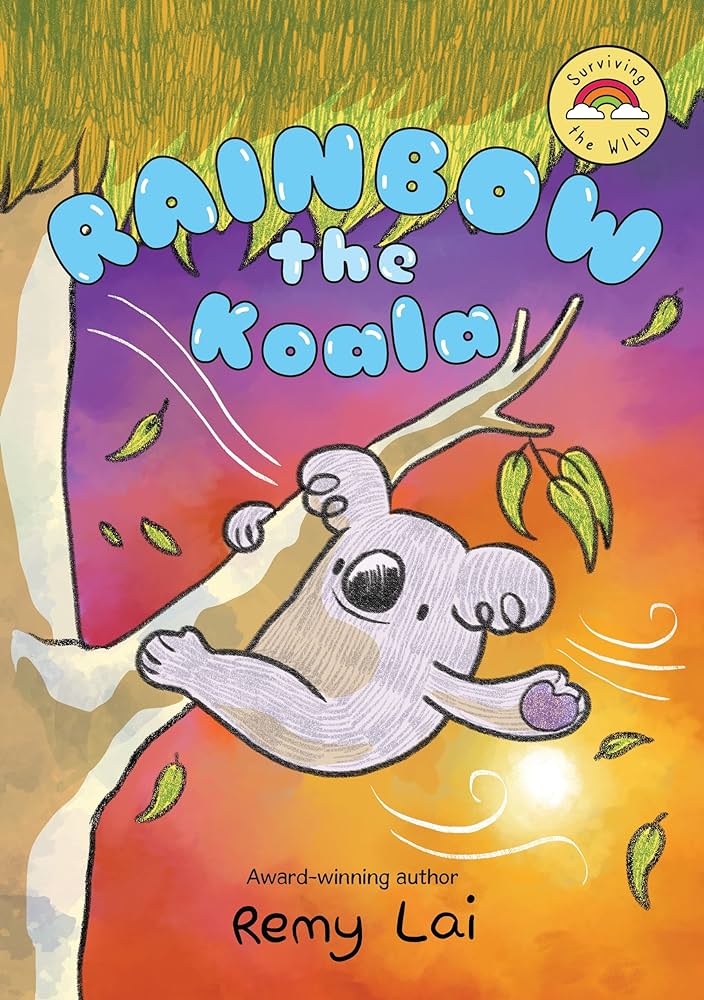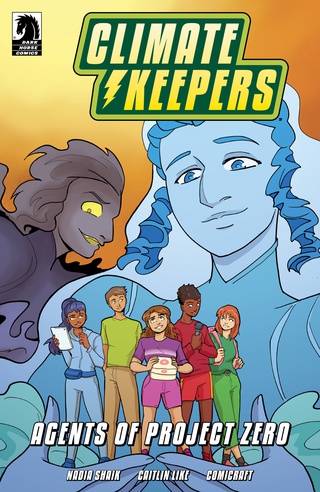“Oh man, this is making me sad, thinking about the terrible shape I’m in. And the humans ignoring the Scientific Method are making me even more sad” — Planet Earth, AstroNuts Mission Two: The Water Planet, n. pag.
| Creator(s) | Jon Scieszka (author), Steven Weinberg (illustrator) |
| Publisher | Chronicle Books |
| Publication Date | 2020 |
| Genre | Science Fiction, Animal Comic, Fiction |
| Environmental Themes and Issues | Animals in Danger, Anthropomorphism, Climate Change, Conservation, Consumerism, Coral Reef Bleaching, Educational Nature Facts, Extinction, Factory Farming, Habitat Destruction, Melting Ice Caps, Mutated Organisms, Ocean Conservation, Pollution |
| Protagonist’s Identity | Nonhuman (Animal) ensemble cast. 2 female and 2 male characters. |
| Protagonist’s Level of Environmental Agency | Level 5: High Environmental Agency and Activism |
| Target Audience | Middle Grade |
| Settings | Outer Space |
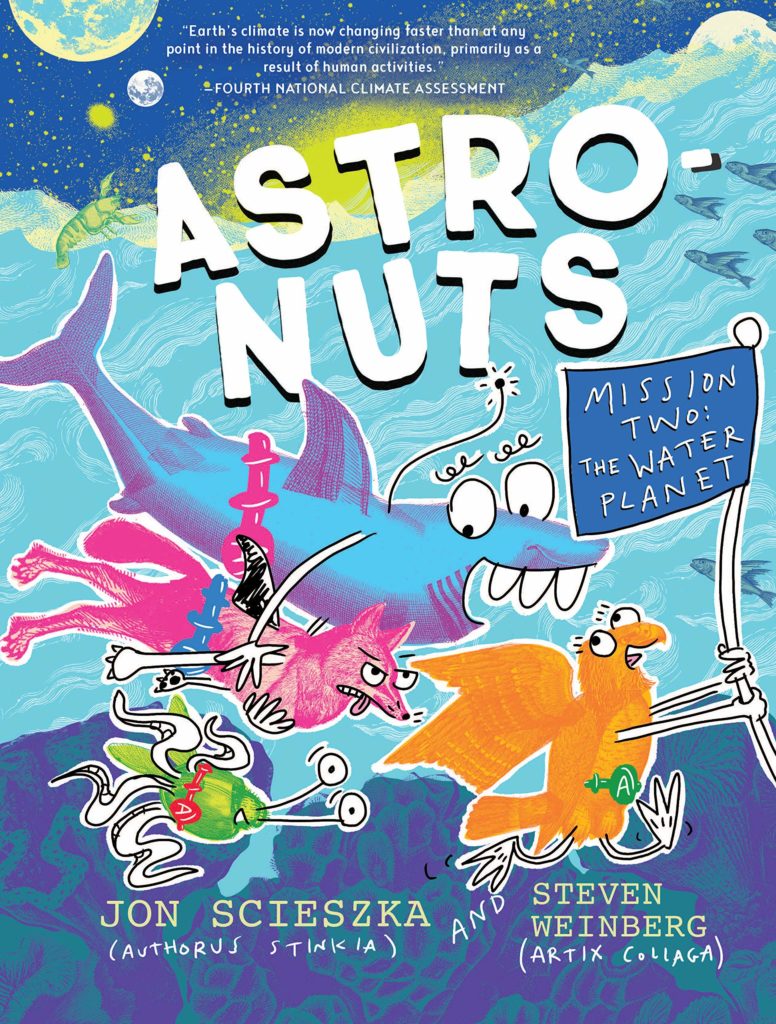
Environmental Themes
AstroNuts Mission Two: The Water Planet is the second volume in the AstroNuts series, published a year after AstroNuts Mission One: The Plant Planet. Creators Jon Scieszka and Steven Weinberg produced the comic from a mixture of hand-drawn illustrations and collaged images taken from the Rijksmuseum in Amsterdam. The comedic science fiction series depicts the outer space explorations of the “AstroNuts,” a group of anthropomorphic, talking animals created by Not the National Aeronautics and Space Administration (NNASA). The AstroNuts team includes AlphaWolf (a timber wolf), SmartHawk (a broad-winged hawk), LaserShark (a great white shark), and Stinkbug (a dung beetle). Human scientists have modified the animals, giving them special abilities that enable them to travel through space in search of a perfect “Goldilocks” planet that humans can resettle on after destroying the Earth’s environment.
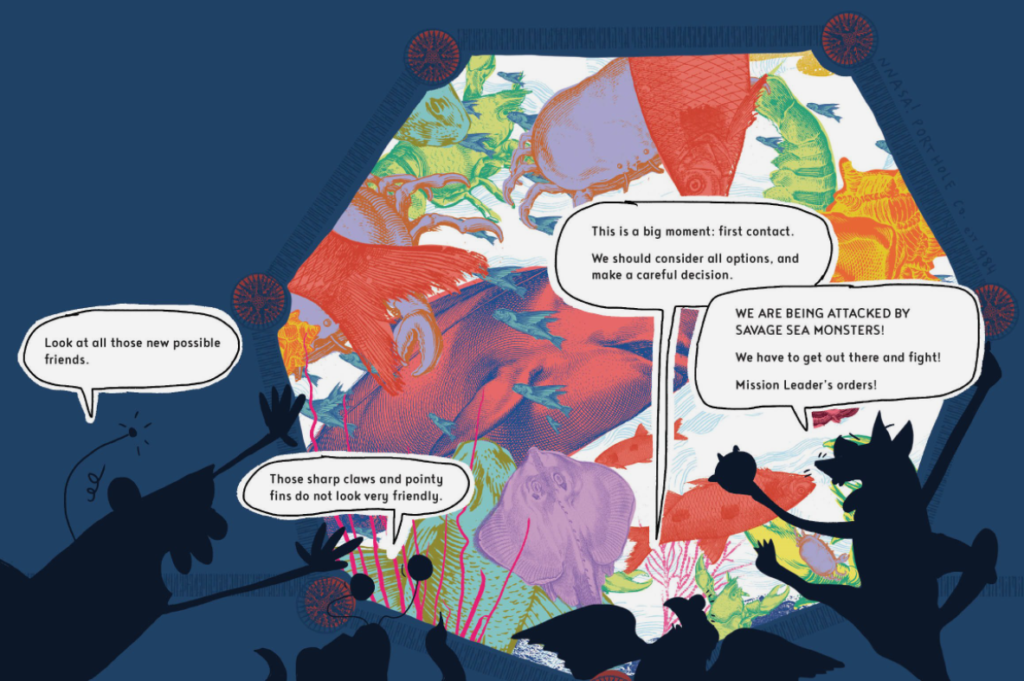
Volume two begins with narration about environmental crises provided by the Earth itself. Addressing the implied young reader directly, the planet lists some of the environmental issues caused by “your human activities [that] are messing with my water“: “My sea ice is melting. My sea levels are rising. Algae is growing out of control. Plastic pollution is making huge garbage patches in my oceans. My oceans are turning more acidic. My coral reefs are dying. Fish species are going extinct. If this keeps up, I am going to be called ‘The Big Polluted Mess’ instead of ‘The Big Blue Marble'” (Scieszka n. pag.). The AstroNuts land on the Water Planet in search of a more habitable environment free from the issues plaguing the Earth. Intelligent and talking clams dominate the planet and exploit its resources, similar to humans on Earth. The clams enthusiastically welcome the AstroNuts to their planet, and President Clam makes a proposal: “To swap planets! You get this beautiful, hardly-used-at-all, land-built-just-for-humans planet. And we take that polluted, overheated, acid-water, coral-reef-dying junker of a planet Earth off your hands. And WHY, you might ask? Because we like you. And filtering water is what we clams do. We can happily filter and clean Earth water” ( Scieszka n. pag.). Believing that the proposal will allow him to attain acclaim, AlphaWolf immediately wants to accept the swap. However, the other AstroNuts remain suspicious of the clams’ intention and insist on conducting scientific inquiries to assess the Water Planet’s suitability for humans.
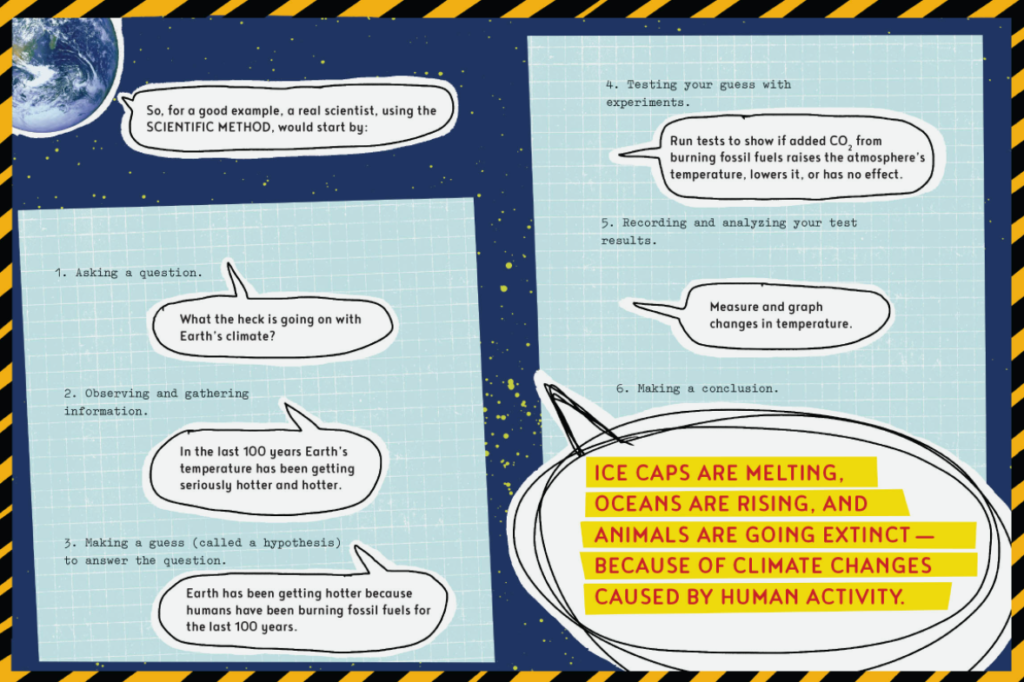
Before the AstroNuts can finish their evaluations, Susan B. Clamthony, a leader in the Clam Resistance, visits their shuttle. She discloses that the other clams have wrecked the Water Planet for profit and will do the same to the Earth if the swap happens. To prove her claims, she takes the disguised AstroNuts on a real tour of the Water Planet, including Fishburger Ranch, where the clams raise fish in cages and process them into burgers. Susan also shows them polluted water, a graveyard of coral killed by warming ocean waters, and an enormous garbage patch filled with plastics. She remarks, “President P. T. Clam and the Clam Senate are wrecking everything so they can buy more fancy castles and more fancy new shoes every day. They do not care about their fellow clams or their planet. In fact, all of their businesses have harmed the planet” (Scieszka n. pag.). The Earth narrator explicitly draws parallels between the greedy clams and humans. Before the AstroNuts can aid the Clam Resistance, the clam police capture them all. The Earth animals use their special abilities to help the Clam Resistance escape and defeat the capitalist clams and their army of mutated sea monsters. Triumphant, the AstroNuts return to Earth to prepare for their third and final mission, aware that time is running out for the Earth.
Throughout the comedic narrative, the comic includes explicitly pedagogical segments. For instance, the Earth interrupts the narrative with an explanation of the scientific method. Additionally, the Earth also promotes scientific inquiry and provides facts about Earth and the environmental issues afflicting it throughout the comic. Finally, the overt parallels between the capitalist clams and human beings also invites children to consider the harmful consequences that occur when one dominant species exploits and destroys a planet for their own gain.
